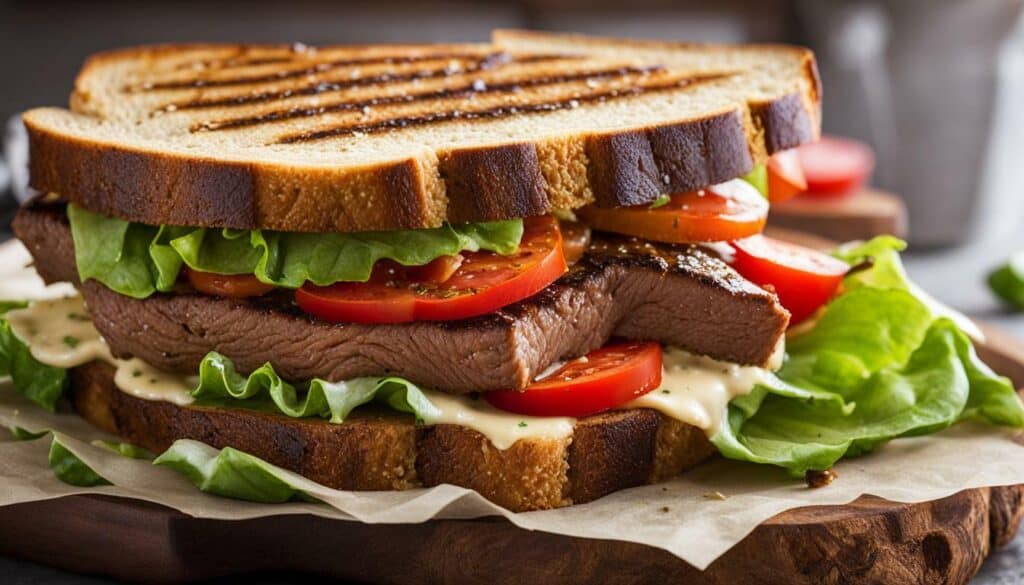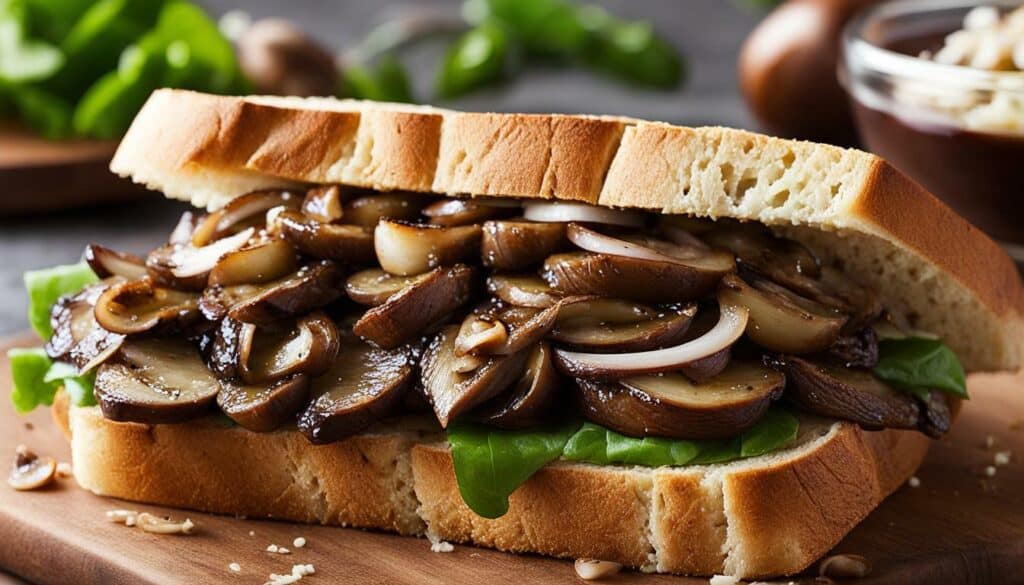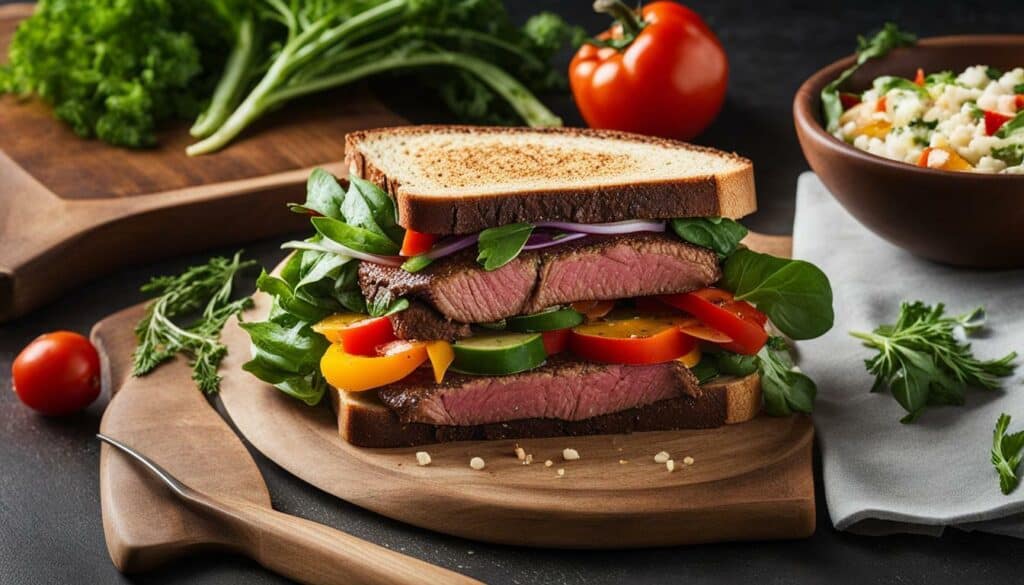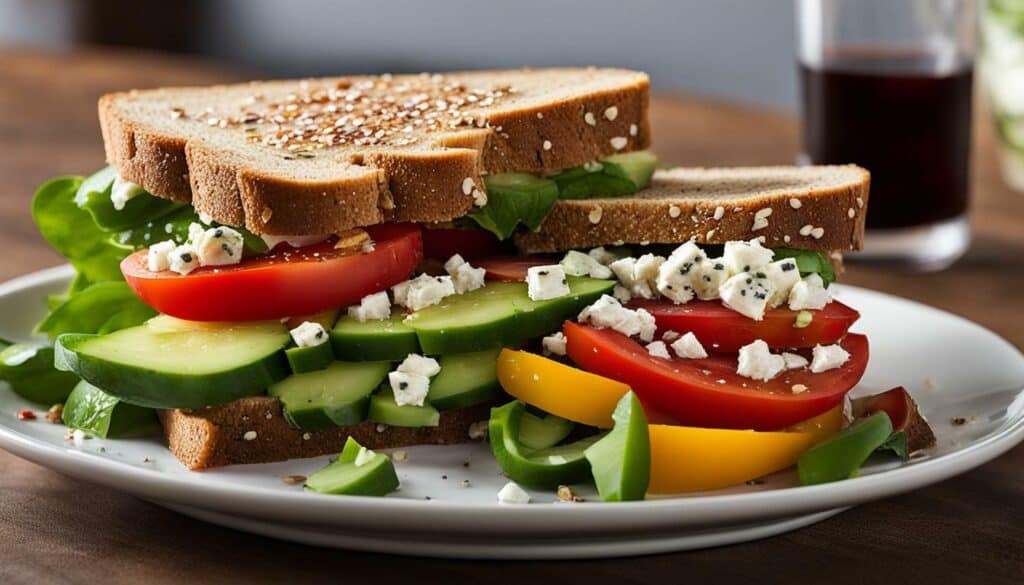Have you ever wondered about the calories in your favorite steak sandwich? Many of us enjoy indulging in this delicious meal, but it’s important to understand the nutritional facts behind it. Counting calories can be a helpful tool for weight management, but it’s crucial to look beyond the numbers and consider the overall nutritional value of the food we consume.
- Not all calories are created equal, so it’s important to consider the nutritional content and composition of the food.
- Foods high in fiber can keep you feeling full for longer, helping prevent overeating.
- Choosing lower-fat options allows you to enjoy larger portions without exceeding your calorie intake.
- Accurately counting calories can be challenging, as people often underestimate their consumption.
- Focus on portion control and prioritize nutrient-dense foods like fruits, vegetables, and whole grains to create a balanced and healthy diet.
The Nutritional Breakdown of a Steak Sandwich
Let’s dive into the nutritional composition of a steak sandwich and explore the calorie content of its key ingredients. Understanding the nutritional breakdown of this popular meal is essential for making informed dietary choices.
When it comes to a steak sandwich, there are several components to consider. The type of bread, meat, and toppings all contribute to the overall nutritional value. Let’s break it down:
| Ingredient | Calories |
|---|---|
| Steak (4 oz) | 200-250 calories |
| Bread (2 slices) | 150-200 calories |
| Cheese (1 slice) | 80-110 calories |
| Mayonnaise (1 tablespoon) | 90-100 calories |
| Lettuce and Tomato | Negligible calories |
It’s important to note that these calorie counts are approximate and can vary depending on various factors such as portion size and preparation methods. However, this breakdown gives you a general idea of the caloric content of a typical steak sandwich.
Now that we have a better understanding of the nutritional composition, we can make smarter choices when it comes to enjoying a steak sandwich. By opting for leaner cuts of steak, whole wheat bread, and using lighter condiments, we can create a more nutritious version of this beloved meal. Adding fresh vegetables like lettuce and tomatoes can provide additional vitamins and minerals without significantly increasing the calorie count.

Remember, a nutritious steak sandwich is all about balance. By paying attention to portion sizes and incorporating a variety of nutrient-dense ingredients, we can indulge in this classic meal without compromising our health goals. So go ahead and savor that delicious steak sandwich while making each calorie count towards a balanced and wholesome diet.
Understanding Calorie Counting and Weight Management
Counting calories is often seen as a crucial tool for weight management, but it’s essential to look beyond numbers when choosing a healthier sandwich option. While creating a calorie deficit is important for weight loss, obsessing over calories alone can lead to an unhealthy relationship with food. Instead, it’s crucial to consider the nutritional content and composition of the food we consume.
Focusing on fiber: Foods high in fiber, such as whole grains, fruits, and vegetables, provide numerous health benefits. In addition to aiding digestion, fiber-rich foods keep you feeling full for longer periods, reducing the temptation to overeat. When it comes to sandwich options, consider whole-grain bread as a healthier choice that offers more nutrients and fiber compared to white bread.
Choosing lower-fat options: While fat is an essential part of a balanced diet, opting for lower-fat options can allow you to consume larger portions without exceeding your calorie intake. For example, selecting lean cuts of steak or turkey breast for your sandwich can be a wise choice, as they provide adequate protein while being lower in fat compared to fattier cuts.

Enhancing flavor with nutrient-dense toppings:
When it comes to sandwich toppings, consider adding nutrient-dense options like fresh greens, tomatoes, cucumbers, and avocado. These ingredients not only provide essential vitamins and minerals but also add flavor and texture to your sandwich. Instead of heavy dressings or spreads, try using hummus, mustard, or a light vinaigrette to enhance the taste without piling on unnecessary calories.
In conclusion, while counting calories can be a helpful tool for weight management, it’s crucial to adopt a holistic approach to nutrition. By considering factors beyond calories, such as fiber content, fat choices, and nutrient-dense toppings, you can create a healthier and more satisfying sandwich option. Remember, the goal is to make each calorie count towards a balanced and nutritious diet.
The Fallacy of All Calories Being Equal
Contrary to popular belief, not all calories are created equal when it comes to a nutritious steak sandwich. While calorie counting is often seen as a simple way to manage weight, it’s important to understand that the nutritional content and composition of the food play a significant role in determining its impact on our health. Simply focusing on the number of calories consumed can lead to an incomplete understanding of the overall nutritional value of a meal.
One common misconception is that all low-calorie options are equally nutritious. While a steak sandwich with fewer calories may seem like a healthier choice, it’s essential to consider the balance of macronutrients and micronutrients. For example, a steak sandwich made with whole-grain bread, lean steak, and fresh vegetables provides essential vitamins and minerals, along with sustained energy from complex carbohydrates and protein. This nutritious combination can keep you feeling satisfied for longer and support overall well-being.
Additionally, the type of fat consumed can have a significant impact on health. Opting for lean cuts of steak and using healthier cooking methods like grilling or broiling can reduce the saturated fat content of a steak sandwich, making it a more heart-healthy option. Incorporating monounsaturated fats, such as avocado or olive oil, can further enhance the nutritional profile of the meal.
By focusing on the nutritional quality of the ingredients and considering the composition of the meal, we can make each calorie count towards a balanced and healthy diet. It’s important to remember that a nutritious steak sandwich can be enjoyed as part of a well-rounded eating plan, emphasizing whole foods, portion control, and variety.

| Ingredient | Calories | Protein (g) | Fat (g) | Carbohydrates (g) | Fiber (g) |
|---|---|---|---|---|---|
| Whole-grain bread | 100 | 5 | 2 | 18 | 3 |
| Lean steak | 150 | 25 | 5 | 0 | 0 |
| Vegetables | 20 | 1 | 0 | 4 | 2 |
| Avocado | 80 | 1 | 7 | 4 | 3 |
| Total | 350 | 32 | 14 | 26 | 8 |
The Role of Portion Control in Calorie Consumption
Optimal portion control is essential for enjoying a healthy steak sandwich without consuming excessive calories. When it comes to managing your weight and maintaining a balanced diet, it’s not just about the number of calories you consume, but also the size of your portions. By being mindful of portion sizes, you can still indulge in a delicious steak sandwich while keeping your calorie intake in check.
One effective strategy for portion control is to use your hand as a guide. For example, a serving of protein, such as steak, should be about the size of your palm. Similarly, the amount of bread used should be equivalent to one fist. By visualizing these measurements, you can ensure that your sandwich is well-balanced and meets your nutritional needs.
In addition to portion sizes, the toppings you choose for your steak sandwich can significantly impact its overall calorie content. Instead of high-calorie condiments like mayonnaise or creamy dressings, opt for healthier alternatives such as mustard, salsa, or avocado spread. These options provide flavor while keeping the calorie count in check.
Remember, enjoying a steak sandwich doesn’t mean you have to sacrifice taste or nutrition. By practicing portion control and choosing healthier toppings, you can create a satisfying and nutritious meal that aligns with your dietary goals.
| Tips for Portion Control in a Steak Sandwich |
|---|
| Use your hand as a guide for portion sizes: palm-sized serving of protein, a fist-sized amount of bread. |
| Choose healthier toppings like mustard, salsa, or avocado spread instead of high-calorie condiments. |
| Include a variety of vegetables to add flavor and nutrition without adding many calories. |
Accurately Counting Calories and Underestimation
Counting calories accurately can be a tricky task, and underestimating their intake is a common occurrence, especially when preparing a homemade steak sandwich. It’s easy to overlook the hidden calories in ingredients like dressings, spreads, or even the cooking oil used. This underestimation can lead to consuming more calories than anticipated, hindering weight management efforts.
To ensure accuracy, it’s important to carefully measure all the ingredients used in your steak sandwich recipe. You can utilize kitchen scales or measuring cups to determine the precise amounts of bread, meat, toppings, and condiments. Keeping a food diary can also be helpful in tracking your calorie intake and holding yourself accountable.
Remember to account for the cooking methods as well. Grilling or baking the steak instead of frying it can significantly reduce the calorie content. Opting for whole grain bread or wraps can add nutritional value and fiber to your meal, keeping you satisfied for longer periods.

In conclusion, accurately counting calories in a homemade steak sandwich requires attention to detail. Be mindful of the ingredients used, measure them carefully, and consider healthier cooking methods and ingredient choices. By taking these steps, you can enjoy a delicious and nutritious steak sandwich without compromising your weight management goals.
Prioritizing Nutrient-Dense Foods in a Balanced Diet
Making your steak sandwich more nutritious involves prioritizing nutrient-dense ingredients and incorporating a variety of food groups. By choosing wholesome ingredients, you can enhance the nutritional value of your meal while still indulging in the flavors you love.
Start by selecting a whole grain bread for your sandwich. This will provide fiber, vitamins, and minerals that are essential for a healthy diet. Opt for lean cuts of steak, which are packed with protein and lower in fat. It’s also a good idea to add a generous serving of fresh vegetables, such as leafy greens, tomatoes, and onions, to boost the nutrient content. These vegetables offer vitamins, antioxidants, and fiber, which promote overall well-being.
To create a balanced and nutritious steak sandwich, consider incorporating a variety of food groups. For example, you can include a side of mixed greens or a serving of fresh fruit to increase the nutrient density of your meal. By doing so, you’ll not only make your sandwich more satisfying but also enhance its nutritional profile.
| Ingredient | Nutritional Value |
|---|---|
| Whole grain bread | High in fiber, vitamins, and minerals |
| Lean steak | Rich in protein, low in fat |
| Leafy greens, tomatoes, and onions | Offer vitamins, antioxidants, and fiber |
Remember, a balanced diet is not about restriction, but rather about making informed choices. Enjoy your steak sandwich with a variety of nutrient-dense ingredients, and savor the flavors while nourishing your body.

Let’s explore some strategies to make each calorie count in your steak sandwich, ensuring a nutritious and satisfying meal. Counting calories can be a valuable tool in managing your weight, but it’s important to remember that not all calories are created equal. By considering the nutritional content and composition of the food, you can optimize your sandwich for both taste and health.
One effective strategy is to focus on incorporating fiber-rich ingredients into your steak sandwich. Foods high in fiber, such as whole wheat bread or leafy greens, can keep you feeling full for longer periods, curbing the temptation to overeat. Additionally, these fiber-rich ingredients offer essential nutrients and contribute to a healthy digestive system.
“Choosing lower-fat options can also make a big difference.”
Choosing lower-fat options can also make a big difference in your calorie intake. For example, opt for lean cuts of steak or use a lighter dressing instead of mayo to reduce the overall fat content. By doing so, you can enjoy larger portions without exceeding your calorie goals.
It’s important to acknowledge that accurately counting calories can be challenging, and many people tend to underestimate the number of calories they consume. Instead of fixating on the numbers, a more practical approach is to focus on portion control. By paying attention to the size of your steak sandwich and incorporating nutrient-dense ingredients like fruits and vegetables, you can create a balanced and satisfying meal that keeps you on track with your health goals.

| Ingredient | Calories | Protein (g) | Fat (g) |
|---|---|---|---|
| Whole Wheat Bread | 80 | 3 | 1 |
| Lean Steak | 150 | 20 | 5 |
| Leafy Greens | 10 | 1 | 0 |
| Tomatoes | 20 | 1 | 0 |
| Light Dressing | 30 | 0 | 2 |
| Total | 290 | 25 | 8 |
By following these strategies and incorporating nutrient-dense ingredients, you can transform your steak sandwich into a low-calorie, nutritious, and satisfying meal. Remember, it’s not just about the numbers on the scale, but also about nourishing your body with the right choices. Enjoy your delicious steak sandwich guilt-free!
The Truth About Low-Calorie Sandwich Options
Discover the truth about low-calorie sandwich options and how they can contribute to a healthier, guilt-free steak sandwich. When it comes to maintaining a balanced diet, finding healthier alternatives to traditional favorites is key. By making smart choices and incorporating nutrient-dense ingredients, you can enjoy a delicious steak sandwich while keeping your calorie intake in check.
One simple yet effective low-calorie option is to swap out regular bread for whole grain or lettuce wraps. Whole grain bread provides more fiber, vitamins, and minerals compared to white bread, while lettuce wraps offer a low-carb, low-calorie alternative. You can still enjoy the satisfying crunch of bread while reducing your calorie intake and increasing your fiber consumption.
| Ingredient | Calories | Fat (g) | Protein (g) |
|---|---|---|---|
| Whole grain bread | 80 | 1 | 4 |
| Lettuce wrap | 10 | 0 | 0 |
In addition to modifying the bread component, choosing lean cuts of steak and incorporating plenty of vegetables can further reduce the calorie content of your sandwich. Opt for sirloin or tenderloin cuts, which are lower in fat, and load up on colorful vegetables such as bell peppers, onions, and tomatoes. These additions not only provide essential nutrients but also add flavor and texture to your steak sandwich.
“By making smart choices and incorporating nutrient-dense ingredients, you can enjoy a delicious steak sandwich while keeping your calorie intake in check.”
To add a burst of flavor without excess calories, consider using marinades or salsas instead of heavy sauces or spreads. A tangy salsa with fresh herbs can enhance the taste of your sandwich while keeping it light and refreshing. Experimenting with herbs and spices like garlic, basil, or paprika can create unique flavors without adding extra calories.
Remember, the goal is to approach your sandwich with a balanced mindset, focusing on nutrient-dense options and portion control. By being mindful of your ingredient choices and using creative alternatives, you can enjoy a satisfying and guilt-free steak sandwich that aligns with your health and wellness goals.

Striking a balance between low-calorie sandwich options and occasional indulgences can lead to a sustainable and enjoyable approach to a healthy lifestyle. While opting for low-calorie sandwich choices can support weight management and overall well-being, it’s important to remember that a healthy diet is not solely defined by calorie intake. By incorporating a variety of nutrient-dense ingredients and allowing for occasional treats, you can create a balanced and nourishing eating plan.
When selecting low-calorie sandwich options, focus on ingredients that provide essential nutrients without compromising taste. Load up on fresh vegetables such as lettuce, tomatoes, and cucumbers, which not only add flavor and crunch but also contribute to your daily fiber and nutrient intake. Whole grains, like whole wheat bread or multigrain wraps, are excellent choices for a low-calorie base, offering complex carbohydrates for sustained energy.
Don’t be afraid to experiment with lean proteins like grilled chicken or turkey breast, as they are lower in fat and calories compared to processed deli meats. To enhance the flavor and nutritional value of your sandwich, consider adding a sprinkle of herbs and spices or a drizzle of healthy condiments like hummus or Greek yogurt-based dressings.
Healthy Sandwich Ideas
If you’re looking to add some variety to your low-calorie sandwich options, consider these nutritious and delicious ideas:
- A Mediterranean-inspired wrap with grilled chicken, feta cheese, chopped olives, and a light tzatziki sauce.
- A veggie-packed sandwich with avocado, sprouts, shredded carrots, and a smear of spicy mustard.
- A protein-packed veggie burger on a whole wheat bun, topped with sliced avocado and a squeeze of fresh lemon juice.
Remember, the key to a balanced approach is not to completely eliminate indulgences but rather to enjoy them in moderation. Treat yourself to a decadent sandwich every once in a while, whether it’s a juicy cheeseburger or a classic Reuben. By savoring these occasional indulgences, you can satisfy cravings while maintaining a healthy relationship with food.
| Sandwich Ingredient | Calories | Protein (g) | Carbohydrates (g) | Fat (g) |
|---|---|---|---|---|
| Whole Wheat Bread | 80 | 4 | 15 | 1 |
| Grilled Chicken Breast | 120 | 26 | 0 | 2 |
| Lettuce | 5 | 0 | 1 | 0 |
| Tomato | 20 | 1 | 4 | 0 |
| Avocado | 160 | 2 | 7 | 15 |
By regularly choosing low-calorie sandwich options that incorporate nutritious ingredients and allowing room for occasional indulgences, you can maintain a balanced and sustainable approach to a healthy lifestyle. Remember, it’s not just about counting calories, but about making each calorie count towards a nourishing and enjoyable eating plan.

Counting calories in a steak sandwich is just one piece of the puzzle, as a balanced approach that considers nutritional value and portion control is key to a healthy and satisfying meal.
While counting calories can be an effective tool for weight management, it’s important to understand that not all calories are created equal. Focusing solely on calorie counting can lead to an unhealthy relationship with food. Instead, it’s crucial to consider other factors such as the nutritional content and composition of the food.
For example, choosing foods high in fiber can keep you feeling full for longer, preventing overeating. Additionally, opting for lower-fat options allows you to consume larger portions without exceeding your calorie intake. It’s worth noting that accurately counting calories can be challenging, and many people tend to underestimate the number of calories they consume.
Therefore, instead of solely relying on calorie counting, it’s beneficial to focus on portion control and prioritize nutrient-dense foods like fruits, vegetables, and whole grains. By making each calorie count towards a balanced and healthy diet, you can enjoy a steak sandwich that not only satisfies your taste buds but also supports your overall well-being.
FAQ
Q: Is counting calories an effective tool for weight management?
A: Yes, counting calories can be an effective tool for weight management, but it’s important to consider other factors as well.
Q: Are all calories created equal?
A: No, not all calories are created equal. It’s important to consider the nutritional content and composition of the food, not just the calorie count.
Q: How can I feel fuller for longer and prevent overeating?
A: Choosing foods high in fiber, like fruits and vegetables, can help you feel fuller for longer and prevent overeating.
Q: How can I consume larger portions without exceeding my calorie intake?
A: Choosing lower-fat options can allow you to consume larger portions without exceeding your calorie intake.
Q: Is accurately counting calories challenging?
A: Yes, accurately counting calories can be challenging, and people often underestimate the number of calories they consume.
Q: What should I focus on instead of solely relying on calorie counting?
A: Instead of solely relying on calorie counting, it’s beneficial to focus on portion control and prioritize nutrient-dense foods like fruits, vegetables, and whole grains.
Q: What should my goal be when it comes to calories?
A: The goal should be to make each calorie count towards a balanced and healthy diet.
How Many Carbs are in a Steak Sandwich Compared to Chicken Fried Steak?
When it comes to counting carbs in chicken fried steak versus a steak sandwich, there is a significant difference. A typical steak sandwich contains around 35-45 grams of carbs due to the bread and other condiments. On the other hand, chicken fried steak is usually breaded and fried, which significantly increases its carb content, often exceeding 60 grams or more.





Leave a Reply